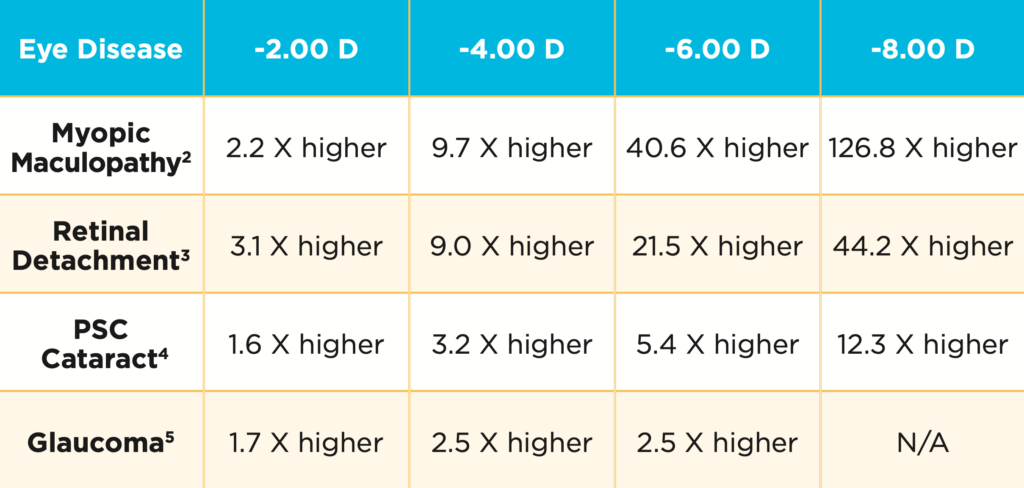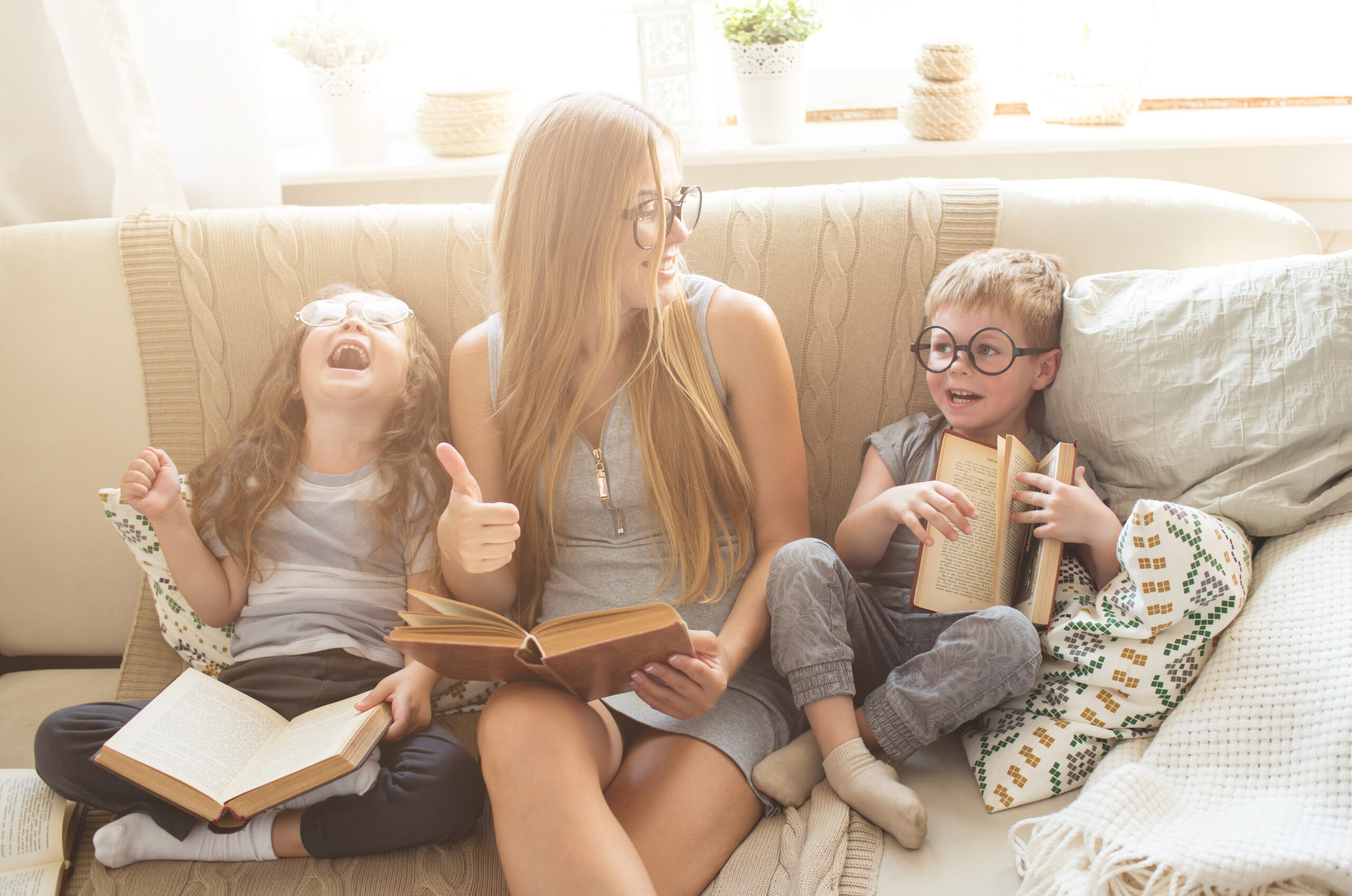Myopia Control
What is myopia?
Myopia, or nearsightedness, is a common problem resulting in blurred distance vision. Myopia occurs when the eyeball grows too long, or when the cornea (the clear front part of the eye) becomes too curved. It usually begins in childhood and progresses until young adulthood when it stabilizes. Normally, myopia worsens every year leading to stronger glasses with thicker, heavier lenses.
While there is no safe amount of myopia, higher myopia increases the risk of developing serious, sight threatening complications such as myopic maculopathy, retinal detachment, glaucoma, and early development of cataracts compared to someone who doesn’t have myopia.
The good news is there is a lot of research and treatments available to slow myopia progression.

What causes myopia?
It can be caused by a variety of different factors, some of which are out of our control.

Genetics
Myopia can be hereditary. For example, a person with one nearsighted parent has 3 times the risk of developing myopia, or 6 times the risk if both parents are nearsighted. Research also suggests a link between Asian ethnicity and faster progression of myopia.

Increased near work
Spending more time on close work has been linked to development of myopia. This includes reading and using smartphones or tablets. The rise in the popularity of handheld devices means that children are now exposed to close work from younger ages, increasing their risk of myopia development.

Not enough time outdoors
Research has found spending time outside reduces the chances of becoming nearsighted, and may slow the progression of existing myopia.

Under- or over- correction
Not wearing the correct glasses prescription, or not wearing glasses when they are needed, has been shown to promote the onset and accelerate the progression of myopia.
The number of people affected by myopia is increasing around the world. It is projected that half of the world population will have myopia by 2050, due mainly to lifestyle factors like increased screen time and less time outdoors.
How to slow down myopia progression
Ask about myopia control
Myopia control includes several treatments that slow down the progression of myopia. By slowing down myopia progression, your child is likely to end up with a lower final amount of myopia than they would have without treatment. Benefits of this include better vision-related quality of life, reduced life long risk of vision problems, and better candidacy and visual outcomes with laser eye surgery in adulthood should your child decide they want it.
Standard glasses and contact lenses correct blurred vision but don’t slow down myopia progression. Because myopia cannot be reversed, starting myopia control as soon as possible is important to protect eye health.
Myopia control can begin in children as young as 4 years old.
Did you know?
Laser eye surgery doesn’t “cure” myopia. It can correct the blurred vision from myopia but it doesn’t shorten the length of the eye. It’s the length of the eyeball and the stretching of the tissues in the eye that are linked to the risk of eye conditions associated with myopia. This means even after laser surgery, the risks associated with myopia remain the same and eye health should be monitored regularly
Myopia control treatment options
MiSight is a multifocal soft contact lens that corrects nearsightedness and is Health Canada approved to slow the progression of myopia in children as young as 6 years old by 59%.
These daily disposable lenses are worn throughout the day and thrown away at the end of each day. Daily disposables are a great option for kids because they don’t need to be disinfected and reused, therefore reducing the risk of infection and contamination.
This is a wonderful option for children who are active, involved in sports where glasses are inconvenient, or simply don’t like wearing glasses full time.
Typically, multifocal contact lenses are used to improve intermediate and near vision for people over the age of 40 (a common condition called presbyopia). However, these soft contact lenses can also be used off-label to correct nearsightedness and slow progression of myopia in children by 45%.
These are monthly replacement lenses that are worn during waking hours and removed, cleaned, and stored overnight. They are reused for 4 weeks before disposal and starting a fresh pair of lenses.
We recommend this type of lens for children who don’t meet the criteria for MiSight contact lenses.
Are contact lenses safe for kids?
Contact lenses are just as safe for kids as they are for adults! If contact lenses are worn, replaced, and disinfected appropriately, contact lens complications are no more prevalent in children than in adults.
Atropine eye drops can be used off label to slow the progression of myopia in children as young as 4 years old by about 50%.
One drop will need to be put in your child’s eyes every night before bed. Children on atropine treatment will still need glasses or contact lenses to see clearly. Atropine does not correct blurred vision from myopia, it only works to slow myopia progression.
Depending on the concentration, low dose atropine has been shown to have no side effects to minimal side effects including blurred vision at near and light sensitivity, both of which can be managed with additional features on spectacle lenses. Atropine eye drops are prescribed at low concentrations to reduce side effects.
MiyoSmart lens is a special lens you can put in any frame. It corrects nearsightedness and is Health Canada approved to slow the progression of myopia in children as young as 6 years old by 60%.
MiyoSmart lenses work due to Defocus Incorporated Multiple Segments (D.I.M.S) technology. The lens has a central clear zone providing your child with sharp vision for distance and reading. Outside of the clear zone, is a ring shaped, honeycomb pattern treatment zone of multiple defocus segments. These defocus segments cause peripheral light to focus in front of the retina, rather than behind it like traditional eyeglass lenses. This altered focus creates a “slow-down” signal for eye growth, controlling myopia.
Which myopia control option is best for my child?
There is no single treatment which is clearly better than the rest. All of these options have a similar effect to slow myopia progression in children. This means the best option for your child will depend on many factors including their prescription, eye health, hobbies, and what best suits you as a family.
